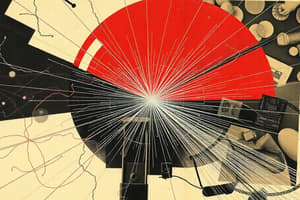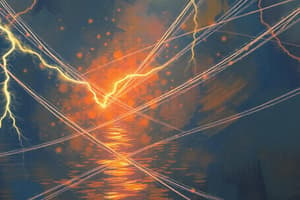Podcast
Questions and Answers
A positively charged particle moves horizontally through a magnetic field that is directed vertically upward. In what direction will the magnetic force act on the particle?
A positively charged particle moves horizontally through a magnetic field that is directed vertically upward. In what direction will the magnetic force act on the particle?
- The magnetic force will be zero
- Horizontally in the same direction as the particle's motion
- Horizontally perpendicular to the particle's motion (correct)
- Vertically downward
A transformer is used to step down the voltage from 2400 V to 240 V. If the primary coil has 1000 turns, how many turns does the secondary coil have?
A transformer is used to step down the voltage from 2400 V to 240 V. If the primary coil has 1000 turns, how many turns does the secondary coil have?
- 10
- 100 (correct)
- 1000
- 10000
Which of the following statements is true regarding Gauss's Law for Magnetism?
Which of the following statements is true regarding Gauss's Law for Magnetism?
- It states that the magnetic flux through any closed surface is proportional to the enclosed current.
- It relates the electric field to the enclosed charge.
- It implies the existence of magnetic monopoles.
- It states that the magnetic flux through any closed surface is zero. (correct)
A wire carries a steady current into a uniform magnetic field. The direction of the magnetic force on the wire is:
A wire carries a steady current into a uniform magnetic field. The direction of the magnetic force on the wire is:
What phenomenon explains how a changing magnetic field can induce a current in a nearby wire loop?
What phenomenon explains how a changing magnetic field can induce a current in a nearby wire loop?
Which of the following is NOT a property of electromagnetic waves?
Which of the following is NOT a property of electromagnetic waves?
If the distance between two point charges is doubled, how does the electrostatic force between them change?
If the distance between two point charges is doubled, how does the electrostatic force between them change?
What is the significance of the Poynting vector in electromagnetism?
What is the significance of the Poynting vector in electromagnetism?
Which of the following materials would be most suitable for enhancing the magnetic field within a solenoid?
Which of the following materials would be most suitable for enhancing the magnetic field within a solenoid?
A capacitor stores 500 microcoulombs of charge when a 100 V potential difference is applied across its plates. What is its capacitance?
A capacitor stores 500 microcoulombs of charge when a 100 V potential difference is applied across its plates. What is its capacitance?
Flashcards
Electromagnetism
Electromagnetism
The study of the electromagnetic force, which mediates interactions between electrically charged particles. It combines electric and magnetic fields as aspects of the same force.
Electric Charge
Electric Charge
A fundamental property of matter causing it to experience a force in electric fields. Exists as positive or negative.
Electric Field
Electric Field
A field of force surrounding an electric charge, exerting force on other charges.
Electric Current
Electric Current
Signup and view all the flashcards
Magnetic Field
Magnetic Field
Signup and view all the flashcards
Electromagnetic Waves
Electromagnetic Waves
Signup and view all the flashcards
Coulomb's Law
Coulomb's Law
Signup and view all the flashcards
Faraday's Law of Induction
Faraday's Law of Induction
Signup and view all the flashcards
Transverse Waves
Transverse Waves
Signup and view all the flashcards
Poynting Vector
Poynting Vector
Signup and view all the flashcards
Study Notes
- Electromagnetism is the study of the electromagnetic force, one of the four fundamental forces in nature, and it mediates interactions between electrically charged particles
- Electric and magnetic fields are intrinsically linked within electromagnetism
Fundamental Concepts
- Electric charge causes matter to experience a force when near other charged matter
- Positive and negative are the two types of electric charges
- Like charges repel, and opposite charges attract
- An electric field is a field of force surrounding an electric charge that exerts force on other charges
- Electric potential refers to the work needed to move a unit positive charge from a reference point to a specific point inside the field
- Electric current is the rate of flow of electric charge through a conductor, measured in amperes (A)
- Magnetic field refers to a field of force created by moving electric charges (electric current) or magnetic materials that exerts a force on other moving charges and magnetic materials
- Magnetic dipole moment gauges an object's tendency to align with a magnetic field
- Electromagnetic waves encompass oscillating electric and magnetic fields propagating through space and transporting energy, like light/radio waves/X-rays
Key Laws and Principles
- Coulomb's Law quantifies the electrostatic force between two point charges
- The electrostatic force is directly proportional to the product of the magnitudes and inversely proportional to the square of the distance between them
- Gauss's Law for Electricity relates the electric field flux through a closed surface to the enclosed electric charge, and is useful for calculating electric fields in symmetric situations
- Gauss's Law for Magnetism says the magnetic flux through any closed surface is zero
- Magnetic monopoles (isolated north or south poles) do not exist
- Ampère's Law relates the magnetic field around a closed loop to the electric current through the loop, useful for calculating magnetic fields from current-carrying wires and solenoids
- Faraday's Law of Induction says changing magnetic field induces an electromotive force (EMF), which can drive an electric current in a closed circuit
- Lenz's Law states the induced current opposes the change in magnetic flux that produced it
- Maxwell's Equations consist of four equations that form the foundation of classical electromagnetism
- These equations describe how electric and magnetic fields are produced by charges and currents, and how these fields change over time and space
Electric Fields
- Electric field lines visualize electric fields via density indicating strength and direction which indicates force on a positive test charge
- Conductors in Electrostatic Equilibrium means the electric field inside a conductor is zero, excess charge resides on the surface, and electric field at the surface is perpendicular to it
- Capacitance measures a capacitor's ability to store electric charge
- Capacitance equals the ratio of charge stored to the potential difference across the capacitor
Magnetic Fields
- Magnetic field lines visualize magnetic fields via direction and density indicating field direction and strength
- The magnetic force on a moving charge is perpendicular to both the velocity and magnetic field, causing circular or helical motion
- Magnetic materials exhibit magnetic properties classified as ferromagnetic, paramagnetic, or diamagnetic based on response to external magnetic field
Electromagnetic Induction
- Motional EMF occurs in a conductor moving through a magnetic field
- Generators convert mechanical energy into electrical energy using electromagnetic induction
- Transformers increase or decrease AC voltage using electromagnetic induction, and consist of coils wound around a magnetic core
Electromagnetic Waves
- Electromagnetic waves are transverse, meaning electric/magnetic fields are perpendicular to propagation direction
- The speed of electromagnetic waves in a vacuum is constant, denoted as c, approximately 3 x 10^8 meters per second
- The electromagnetic spectrum ranges all possible frequencies of electromagnetic radiation including radio/microwaves, infrared, visible light, ultraviolet, X-rays, and gamma rays
- Poynting Vector represents energy flux (power per unit area) of an electromagnetic wave, with its direction indicating energy propagation
Applications
- Electric circuits utilize electric current flow for power distribution and electronic devices
- Electric motors convert electrical energy into mechanical energy via magnetic fields and electric currents
- Radio communication transmits information over long distances via electromagnetic waves
- Medical imaging techniques like MRI use magnetic fields and radio waves to image the human body
- Optical fibers use light (an electromagnetic wave) to transmit data over long distances with high bandwidth
Studying That Suits You
Use AI to generate personalized quizzes and flashcards to suit your learning preferences.




